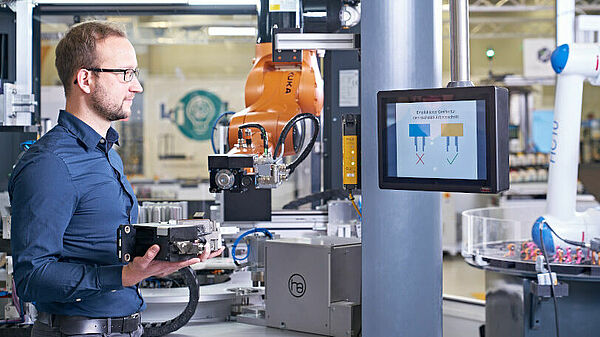With Industrie 4.0, a completely new machine architecture is developing based on digital representations that map real components and machines in analog form. This increases the complexity in the engineering of distributed and adaptable production systems and the requirements for Industrie 4.0-compliant communication, which must be consistent, interoperable and manufacturer-independent.
Robust, secure and real-time capable communication solutions for industry, as well as end-to-end and function-oriented engineering for industrial applications based on open standards such as OPC UA, were therefore the main goals set out almost four years ago when the project "DEVEKOS: Integrated Engineering for Secure, Distributed and Communicating Multicomponent Systems" was launched. At that time, the visions were still confronted with obstacles in industrial practice, which were mainly due to unresolved issues of the highly distributed network communicating in real time and the insufficient consistency in the engineering process. Over the course of the last few years, however, these obstacles have been overcome, so that on March 31, 2021, the successful completion of the project - unfortunately only digitally for the time being due to the pandemic - could be celebrated.
The Institute Industrial IT (inIT) at the Ostwestfalen-Lippe University of Applied Sciences and Arts played a key role in the results achieved. With the Plug & Play principle, the researchers have managed to noticeably reduce the commissioning and modification efforts of plants and machines. Based on OPC UA, object-oriented machine architectures were also implemented. "Also with OPC UA, we have managed to enable open and consistent communication. This is manufacturer-independent and interoperable and thus fulfills the Industrie 4.0 basic requirements. In addition, OPC UA technology was also the key to a new kind of interoperable and fully skill-based control concept," explain Philip Priss and André Mankowski, research assistants at inIT. "The prominent topic of digital twins and their networking also became the focus of our work, especially in the last year of the project, and will continue to play a central role in the further development of DEVEKOS concepts in other follow-up projects," says Prof. Dr.-Ing. Henning Trsek, at whose chair these topics will be further developed in the future.
In addition to technical publications on the national and international stage, the results developed were of course also tested in practice and implemented at the SmartFactoryOWL in Lemgo, among other places. Here, together with the VDMA working group IAS (Integrated Assembly Solutions), a manufacturing cell for a fidget spinner production was brought to life as an exemplary demonstration platform, which implements an object-oriented and capability-based machine architecture with complete manufacturer interoperability using OPC UA.
The project results were also successfully implemented in pilot projects at the project partners Häcker Automation GmbH and Harro Höflinger Verpackungsmaschinen GmbH, and thus the transfer to industry could also be reported as successful.
The other DEVEKOS project partners include the consortium leader Festo SE & Co. KG, ASYS Automationssysteme GmbH, CODESYS GmbH, elrest Automationssysteme GmbH, fortiss GmbH, the Institute for Control Engineering of Machine Tools and Manufacturing Units (ISW) at the University of Stuttgart, NewTec GmbH, Schaeff Maschinen GmbH & Co. KG (afag Automation AG, eps GmbH, TBK GmbH) and Softing Industrial Automation GmbH. "Not least due to the extraordinarily effective and close cooperation of all project partners, who were always committed and focused despite the relatively long project duration of four years in total, this project could be a great success. This project has impressively shown how much interdisciplinarity and a common understanding of goals pay off," says André Mankowski, praising his fellow project members. "We would also like to take this opportunity to express our special thanks to Mr. Hoos from Festo for his excellent project coordination and consortium management, as well as to the DLR project management agency for its excellent support of the project," adds research group leader Natalia Moriz.
The project also deepened the cooperation with the Verband Deutscher Maschinen- und Anlagenbau (VDMA). This was characterized, among other things, by the new founding of the VDMA sub-working group SOArc (Service-Oriented-Architecture and real time control), which is initially responsible for the development of an OPC UA Companion Specification for capability-based engineering as well as an OPC UA Pub/Sub standard extension to include client/server-like method concepts.
The DEVEKOS project was funded by the German Federal Ministry for Economic Affairs and Energy (BMWi) and managed by the Deutsches Zentrum für Luft- und Raumfahrt e.V. (DLR).


